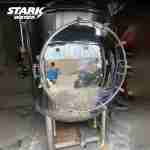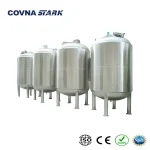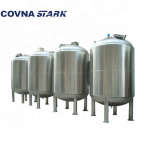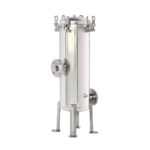1) What actually changes between 304 and 316L
- Alloying
304 uses chromium and nickel for corrosion resistance. 316L adds molybdenum, improving resistance to pitting and crevice corrosion in chloride media. The “L” means low carbon for better weldability and lower risk of sensitization. - Corrosion behavior
316L resists localized attack from chlorides better than 304, especially at elevated temperature or in stagnant zones. 304 is robust for low-chloride water at ambient conditions. - Hygiene and finishing
Both alloys support sanitary TIG welding and passivation. For high-purity service, 316L with a lower Ra target and optional electropolish helps cleaning and reduces residue attachment. - Mechanical and fabrication
For atmospheric tanks, strength differences are minor in practice. Weld procedures and post-treatment quality matter more than nominal alloy strength.
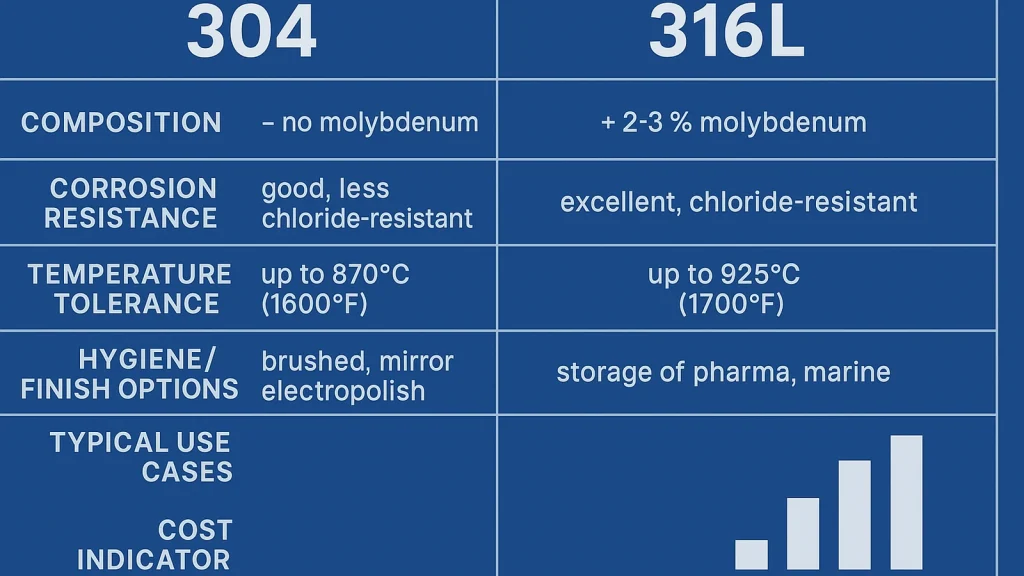
2) When 304 is the right choice
Use 304 if the water and environment have low chloride levels and operate near ambient temperature.
Typical cases:
- Utility water, RO/DI buffer for general industry
- Beverage or food plants with controlled cleaning chemistry
- HVAC or process buffers where thermal cycling is mild
- Budget-sensitive projects that still require stainless and sanitary construction
Avoid 304 if:
- Airborne sea salt or de-icing salts are present around the tank
- Cleaning uses hot alkaline with chloride carryover or chlorinated disinfectants
- The process has warm stagnant pockets that cannot be flushed
3) When 316L is the safer choice
Pick 316L when any of these apply:
- High-purity or pharmaceutical expectations for hygiene and documentation
- Elevated temperature, intermittent heat, or higher chloride exposure
- Exterior is exposed to marine atmosphere or splashes
- Cleaning chemistry is demanding and cycles are frequent
Notes:
- 316L is more resistant, not invulnerable. Chloride stress corrosion can still occur under high temperature and stress. Good design, flushing, and controlled chemistry are essential.
4) Interior finish and roughness targets
- Brushed (typical Ra 0.8–1.6 um): adequate for utility and many beverage applications.
- Mirror: improves cleanability and appearance; may not reduce Ra enough alone.
- Electropolished: removes micropeaks, lowers Ra, and helps cleaning validation; preferred for pharma and high-purity lines.
Choose the finish with your cleaning method in mind. A well-placed spray ball and a conical bottom or true lowest-point outlet often reduce cleaning time more than finish alone.
5) Cleaning and materials compatibility
- Prefer non-chloride detergents where possible.
- Rinse thoroughly after cleaners and disinfectants.
- Keep gaskets compatible with temperature and media (EPDM or silicone are common for water).
- Plan for a sterile vent if the tank must breathe clean air during cooling.
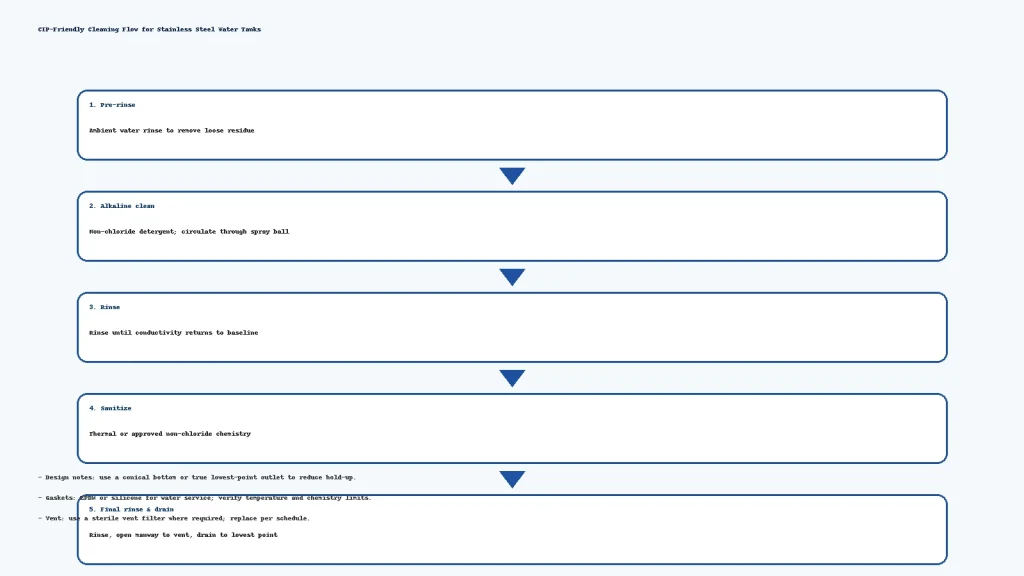
6) Quick selection matrix
| Scenario | Prefer 304 | Prefer 316L |
|---|---|---|
| Low-chloride water at ambient | Yes | |
| High-purity or validation-driven service | Yes | |
| Marine atmosphere or de-icing salt nearby | Yes | |
| Aggressive cleaning or frequent cycles | Yes | |
| Tight budget, controlled chemistry | Yes | |
| Warm stagnant zones difficult to flush | Yes |
7) Spec template you can copy
Tank: Stainless steel water tank, atmospheric and vented
Alloy: 304 (or 316L if chloride/high-purity applies)
Layout: Vertical on legs with conical bottom (or horizontal on saddles for low height)
Interior finish: Brushed; target Ra per service (EP optional for high-purity)
Connections: Tri-clamp sanitary; ANSI/DIN flanges where required
Nozzles: Inlet DN25–DN50; Outlet at lowest point; Vent; CIP; Instruments
Documents: Leak or hydrostatic test; material certs; passivation record
Options: Insulation with SS jacket; spray ball; level transmitter; sterile vent
8) Real examples on our site
- Pharma case — 1500L 316L sterile vertical, electropolished:
/pharma-1500l-316l-sterile-vertical-tank-electropolish/ - Beverage case — 10000L horizontal insulated buffer:
/beverage-10000l-horizontal-insulated-buffer-tank/
9) Recommended products
- 500L Vertical Stainless Steel Water Tank:
/stark_product/500l-vertical-stainless-steel-water-tank/ - 500L Horizontal Stainless Steel Water Tank:
/stark_product/500l-horizontal-stainless-steel-water-tank/ - 1000L Vertical Stainless Steel Water Tank:
/stark_product/1000l-vertical-stainless-steel-water-tank/ - 1000L Horizontal Stainless Steel Water Tank:
/stark_product/1000l-horizontal-stainless-steel-water-tank/ - 1500L 316L Sterile Vertical Stainless Steel Water Tank:
/stark_product/1500l-316l-sterile-vertical-stainless-steel-water-tank/ - 2000L Vertical Stainless Steel Water Tank:
/stark_product/2000l-vertical-stainless-steel-water-tank/ - 2000L Horizontal Insulated Stainless Steel Buffer Tank:
/stark_product/2000l-horizontal-insulated-stainless-steel-buffer-tank/ - 10000L Horizontal Stainless Steel Water Tank:
/stark_product/10000l-horizontal-stainless-steel-water-tank/
10) Related reading
- Horizontal vs Vertical Stainless Steel Water Tanks:
/horizontal-vs-vertical-stainless-steel-water-tanks/ - 1000L Stainless Steel Water Tank — Buyer’s Guide:
/1000l-stainless-steel-water-tank-buyers-guide/
FAQ
- Is 316L always better than 304
No. 316L offers better chloride resistance but costs more. If chlorides are low and cleaning is controlled, 304 is a solid choice. - Do I need electropolish for food or beverage
Not always. A brushed interior with good spray coverage often meets requirements. Electropolish helps when you target lower Ra or faster validation. - Can these tanks be pressurized
The pages here describe atmospheric tanks. For pressure service, specify design pressure and applicable code at RFQ stage. - What about insulation
Add insulation with a stainless jacket when temperature stability matters. Horizontal tanks are easy to jacket evenly. - How do I prevent stagnant zones
Use a conical bottom or true low-point outlet, avoid long dead legs, and validate spray coverage.
Call to action
Send your water analysis and cleaning plan for a quick alloy recommendation and quote.
Email: [email protected]

